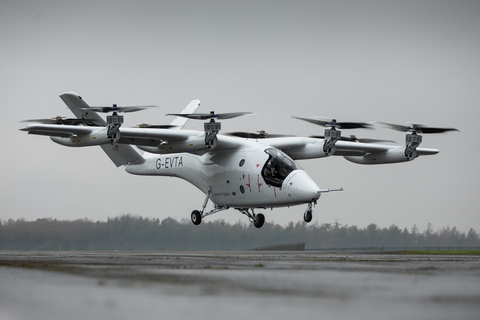VX4 Achieves Major Milestone With Launch of Phase 2 of Piloted Flight Testing
-
Vertical’s VX4 prototype begins untethered, piloted thrustborne testing following expansion of Permit to Fly from the
UK Civil Aviation Authority. - Phase 2 of testing includes vertical take-off and landing and low-speed flight manoeuvres.
- The VX4 prototype has completed nearly 90 test points, measuring 35,000 flight and system parameters, producing several thousand gigabytes of data.

Vertical’s VX4 prototype begins untethered, piloted thrustborne testing. (Photo: Business Wire)
The VX4 prototype, powered by industry-leading battery packs delivering up to 1.4 MW of peak power, surpassed expectations in hover performance, control, and stability. Testing will now progress to low-speed manoeuvres using lift generated by the propellers at its Flight Test Centre at Cotswolds Airport,
Thrustborne flights are designed to assess the aircraft’s stability, battery efficiency, control characteristics, aerodynamics, structural and dynamic loads and performance across different speeds, enabling further assessment of how the VX4 behaves under real-world flight conditions.
This marks an expansion of the VX4’s flight envelope beyond the initial tethered hover condition in Phase 1, as the prototype continues to operate under more demanding conditions, ensuring it meets the most stringent safety and regulatory standards.
The second of four testing phases follows the
Stuart Simpson, CEO of Vertical Aerospace, said: “It's great to see the VX4 throw off the tethers and move to the next phase of our piloted test flight programme. We now enter a realm that very few companies in the world have achieved. Our team is thrilled with the significant strides we continue to make with the VX4 prototype as we expand our learnings and take another step towards connecting communities with faster, cleaner and safer travel.”
Simon Davies, Vertical’s Chief Test Pilot, who flew the VX4 prototype, said: “The aircraft performed absolutely brilliantly, and was really stable in the hover. The flight controls felt good, and it’s great to have the tethers off. Everything on the aircraft worked perfectly - no surprises, nice and boring - a great test flight. Definitely my favourite and most memorable flight in thousands of flight hours, but my job was really easy - standing on the shoulders of giants! So proud of our team.”
Vertical will now progress through Phase 2 while working with the CAA to extend it’s Permit to Fly and move onto Phase 3 - wingborne flight tests. This next stage will involve piloted take-off, flight, and landing like a conventional aircraft using wing-generated lift. The primary focus of this phase is expanding the transition envelope as safely as possible - working down in speed from high altitude rather than up in speed from low altitude, which is much safer. Phase 4 will involve transitioning between thrustborne and wingborne flight modes.
Vertical is currently developing an identical full-scale prototype which will accelerate the VX4’s flight test programme and demonstration capability. Once assembled, the company will take flight test learnings from both prototypes into the design and development of the certified VX4 model.
Notes to editors:
Piloted flight test programme explainer
- Phase 1: Tethered: the VX4 will perform stabilised hover while loosely tethered to the ground. COMPLETE
- Phase 2: Thrustborne: the VX4 will take-off and land vertically and conduct low speed flight manoeuvres with lift generated by the propellers. STARTED
- Phase 3: Wingborne: the VX4 will take-off, fly and land like a conventional aircraft, with lift generated by the wing.
- Phase 4: Transition: The VX4 will transition between thrustborne and wingborne flight, and vice versa.
About Vertical Aerospace
Vertical Aerospace is a global aerospace and technology company pioneering electric aviation. Vertical is creating a safer, cleaner and quieter way to travel. Vertical’s VX4 is a piloted, four passenger, Electric Vertical Take-Off and Landing (eVTOL) aircraft, with zero operating emissions. Vertical combines partnering with leading aerospace companies, including GKN, Honeywell and Leonardo, with developing its own proprietary battery and propeller technology to develop the world’s most advanced and safest eVTOL.
Vertical has c.1,500 pre-orders of the VX4, with customers across four continents, including American Airlines, Japan Airlines, GOL and Bristow. Headquartered in
Forward-Looking Statements
This press release contains forward-looking statements within the meaning of the
to raise additional capital to fund our operations, the differential strategy compared to our peer group, expectations surrounding pre-orders and commitments, our future results of operations and financial position and expected financial performance and operational performance, liquidity, growth and profitability strategies, our plans to mitigate the risk that we are unable to continue as a going concern, our plans for capital expenditures, as well as statements that include the words “expect,” “intend,” “plan,” “believe,” “project,” “forecast,” “estimate,” “may,” “should,” “anticipate,” “will,” “aim,” “potential,” “continue,” “are likely
to” and similar statements of a future or forward-looking nature. Forward-looking statements are neither promises nor guarantees, but involve known and unknown risks and uncertainties that could cause actual results to differ materially from those projected, including, without limitation: our limited operating history without manufactured non-prototype aircraft or completed eVTOL aircraft customer order; our history of losses and the expectation to incur significant expenses and continuing losses for the foreseeable future; the market for eVTOL aircraft being in a relatively early stage; our potential inability to produce, certify or launch aircraft in the volumes or timelines projected; the potential inability to obtain the necessary certifications for production and operation within any projected timeline, or at all; any accidents or incidents involving eVTOL aircraft could harm our business; our dependence on partners and suppliers for the components in our aircraft and for operational needs; the potential that certain strategic partnerships may not materialize into long-term partnership arrangements; all of the preorders received are conditional and may be terminated at any time and any pre-delivery payments may be fully refundable upon certain specified dates; any circumstances; the inability for our aircraft to perform at the level we expect and may have potential defects; any potential failure to effectively manage our growth; our inability to recruit and retain senior management and other highly skilled personnel, our ability to raise additional funds when we need or want them, or at
all, to fund our operations; our limited cash and cash equivalents and recurring losses from our operations raise significant doubt (or raise substantial doubt as contemplated by PCAOB standards) regarding our ability to continue as a going concern; and the other important factors discussed under the caption “Risk Factors” in our Annual Report on Form 20-F filed with the
View source version on businesswire.com: https://www.businesswire.com/news/home/20241112194338/en/
Justin Bates, Head of Communications
justin.bates@vertical-aerospace.com
+44 7878 357 463
Source: Vertical Aerospace








